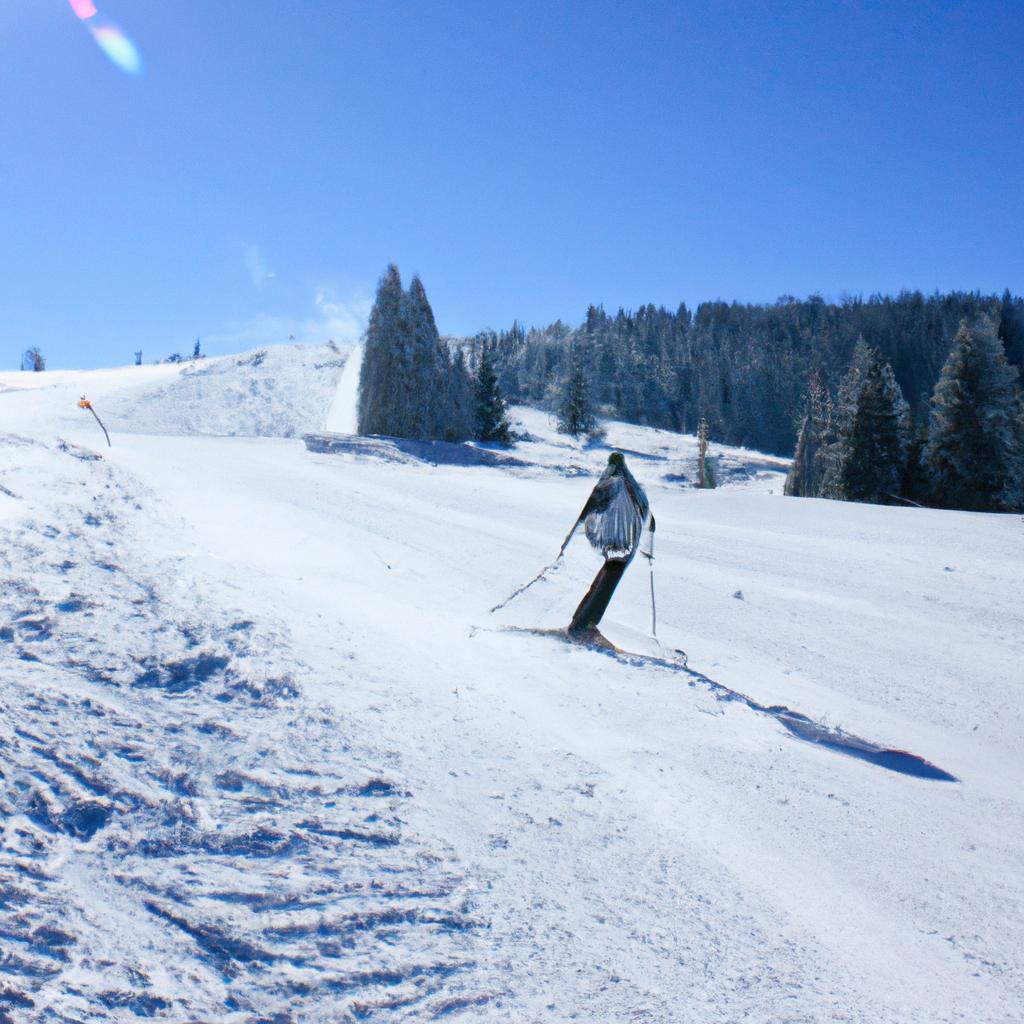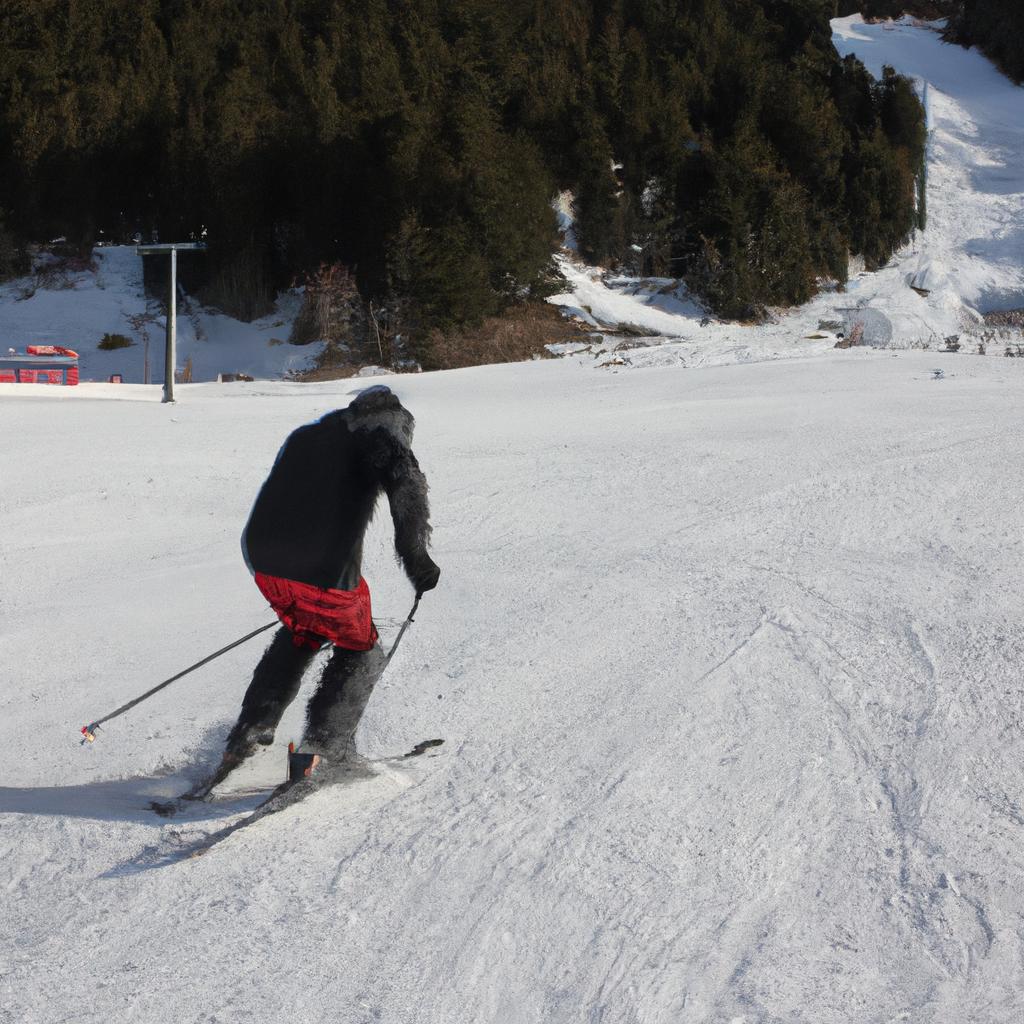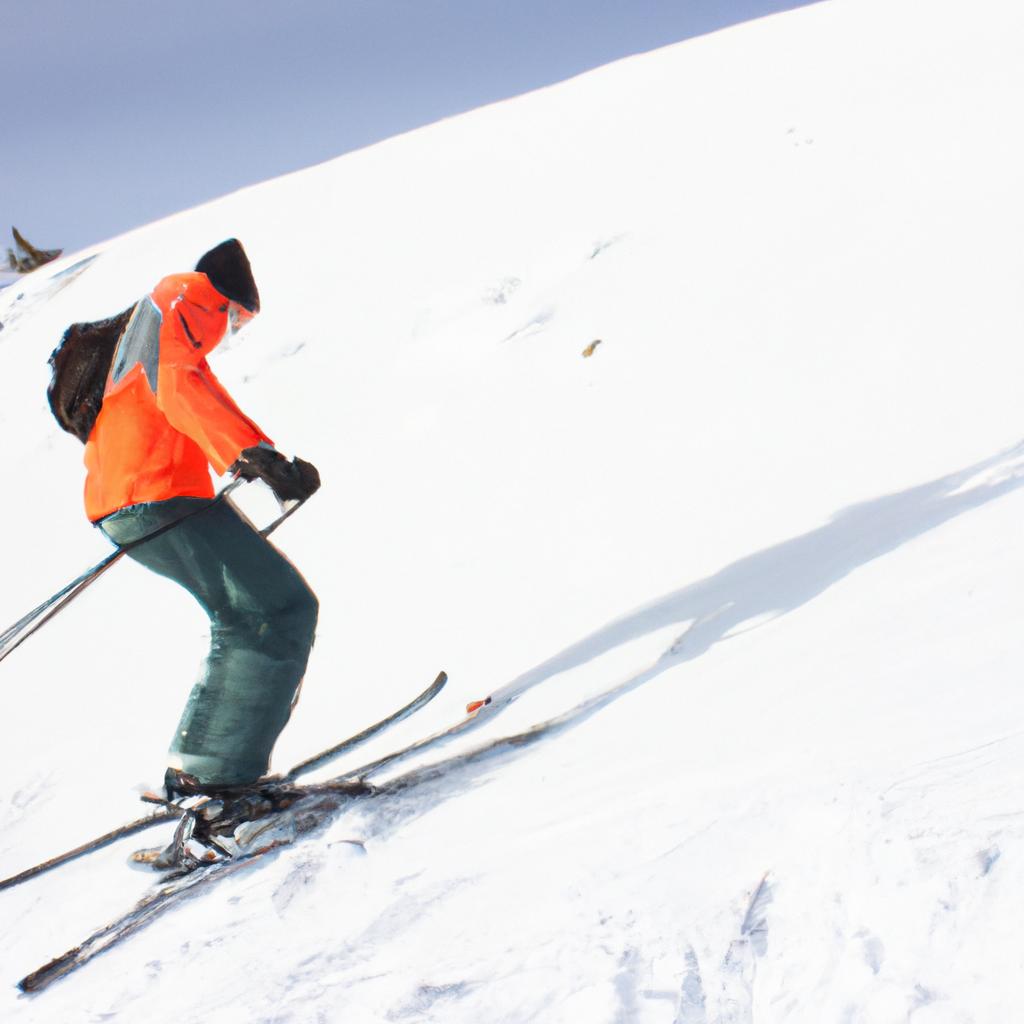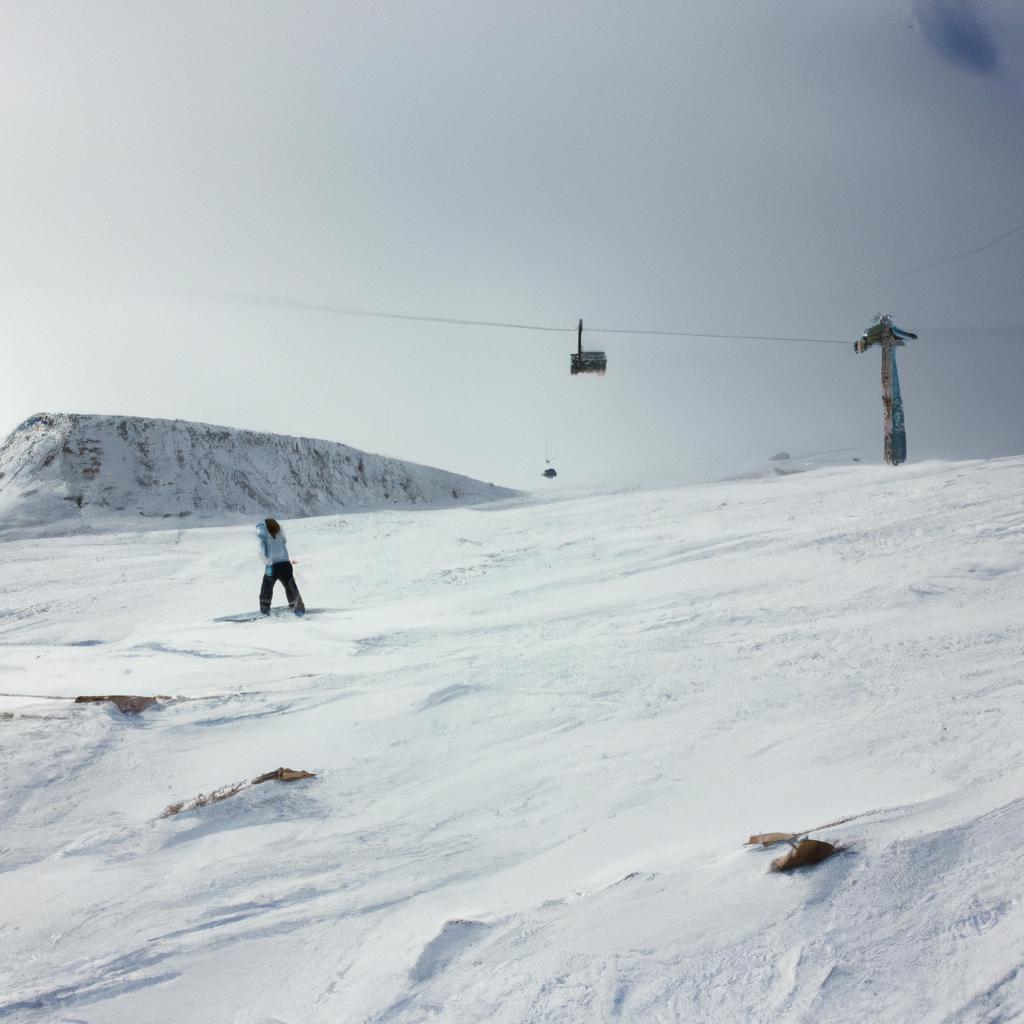Skiing, a popular recreational and sports activity enjoyed by millions of individuals worldwide, requires mastery of various techniques to ensure efficiency, control, and safety on the slopes. Whether one is a beginner seeking to navigate their first gentle slope or an experienced skier aiming to conquer challenging terrains, understanding proper ski techniques is essential. This article serves as a comprehensive guide that explores different ski techniques for both recreational enjoyment and competitive sports.
Consider the case of Sarah, a novice skier who recently discovered her passion for skiing during a winter vacation in the mountains. Excited to improve her skills, she embarks on a journey to explore different skiing techniques suited for her level of expertise. With limited experience but boundless enthusiasm, Sarah encounters obstacles such as maintaining balance while turning at high speeds and controlling her movements on steep descents. Through this article’s examination of various ski techniques, Sarah will gain valuable insights into how to overcome these challenges and progress towards becoming a proficient skier.
In order to fully grasp the intricacies of effective skiing techniques, it is crucial to delve into fundamental concepts such as body positioning, weight distribution, edging maneuvers, and pole usage. By acquiring knowledge about these aspects and implementing them skillfully while navigating downhill slopes or executing dynamic turns , skiers can significantly enhance their skiing abilities and overall enjoyment of the sport.
First and foremost, maintaining proper body positioning is essential for stability and control while skiing. Sarah should focus on keeping her upper body facing downhill, with her shoulders parallel to the slope. This position ensures that her weight is evenly distributed between both skis, promoting balance and preventing any unnecessary strain on her legs or joints.
Next, understanding weight distribution is crucial for executing smooth turns and maneuvers. Sarah should aim to shift her weight slightly forward when initiating a turn, engaging the edges of her skis and allowing them to grip the snow effectively. As she progresses through the turn, she can gradually transfer her weight back towards the center for stability before repeating the process for subsequent turns.
In terms of edging maneuvers, Sarah should familiarize herself with techniques such as carving and skidding. Carving involves applying pressure to the inside edge of the ski throughout a turn, resulting in clean arcs and precise control. Skidding, on the other hand, entails intentionally sliding or drifting the skis sideways during a turn to control speed or navigate tighter spaces. Understanding how to switch between these techniques will give Sarah greater versatility on different slopes and terrain types.
Additionally, pole usage plays a significant role in skiing technique. Sarah should practice coordinating pole plants with each turn to aid in rhythm and timing. Pole plants provide stability while initiating a turn by establishing an anchor point from which she can guide her movements. By planting her poles firmly in the snow at specific intervals during each turn, Sarah can align her body correctly and maintain fluidity throughout.
As Sarah gains confidence and proficiency in these fundamental techniques, she can then explore more advanced ski maneuvers suited for steeper terrains or off-piste adventures. Techniques such as moguls skiing (navigating through bumpy terrain), powder skiing (managing deep snow conditions), and freestyle tricks (performing aerial maneuvers) offer endless possibilities for skiers seeking to push their limits and explore new challenges.
In conclusion, mastering skiing techniques is a journey that requires dedication, practice, and a willingness to continually learn and adapt. By understanding body positioning, weight distribution, edging maneuvers, and pole usage, skiers like Sarah can progress from novice to advanced levels while enjoying the exhilarating experience of skiing. With perseverance and a passion for the sport, Sarah can confidently tackle any slope or terrain she encounters on her skiing adventures.
Choosing the Right Equipment
Skiing is an exhilarating recreational activity that requires careful consideration of various factors, one of which is selecting the appropriate equipment. To illustrate this point, let’s consider a hypothetical scenario. Imagine a beginner skier who decides to rent ski equipment without seeking any professional advice or guidance. As a result, they end up with ill-fitting boots and poorly maintained skis, leading to discomfort and hindered performance on the slopes.
When it comes to choosing ski equipment, there are several essential aspects to keep in mind. First and foremost is ensuring proper fit and comfort. Ill-fitting boots can cause discomfort, blisters, and even injuries during skiing sessions. It is crucial for skiers to consult knowledgeable professionals who can measure their feet accurately and recommend suitable boot sizes.
Secondly, considering the type of terrain or skiing style plays a significant role in selecting the right equipment. Skis designed for powder snow differ from those used on groomed trails or icy slopes. For instance:
- Wide-waisted skis with rocker technology provide better flotation in deep snow.
- Narrower all-mountain skis offer versatility across different types of terrain.
- Carving skis have a smaller turning radius ideal for quick turns on groomed runs.
- Freestyle twin-tip skis are specifically designed for park jumps and tricks.
To further aid in decision-making, below is a table summarizing key considerations when choosing ski equipment:
| Consideration | Benefit |
|---|---|
| Proper Fit | Enhanced Comfort |
| Ski Type | Optimal Performance |
| Skill Level | Suitable Challenge |
| Budget | Cost-effectiveness |
Lastly, taking into account individual skill level is paramount when selecting ski equipment. Beginners may benefit from shorter skis that allow easier maneuverability and control, while advanced skiers might opt for longer models that promote stability at higher speeds. It is also crucial to consider budget constraints, as investing in high-quality equipment can positively impact overall skiing experience.
In the subsequent section about “Mastering Basic Techniques,” skiers will learn fundamental skills necessary for enjoyable and safe skiing adventures. Understanding how these techniques complement proper equipment selection enhances overall proficiency on the slopes.
Mastering Basic Techniques
Having explored the importance of choosing the right equipment for skiing, we can now delve into mastering basic techniques that will enhance your experience on the slopes. Whether you are a beginner or an intermediate skier, understanding and practicing these techniques is essential in improving your skills and ensuring safety.
To illustrate the significance of proper technique, let’s consider a hypothetical scenario. Imagine Sarah, a novice skier excited to hit the slopes for the first time. Without any knowledge of basic ski techniques, she finds herself struggling to maintain balance and control her speed. As a result, fear grips her as she navigates down steep slopes with limited skill.
To prevent such situations, here are four key ski techniques that every recreational skier should focus on:
-
Stance: Adopting a balanced stance is crucial in maintaining stability while skiing. Keep your knees slightly bent and distribute weight evenly between both feet.
-
Turning: Learning how to execute turns effectively is fundamental in maneuvering through various terrains. Initiating turns by shifting body weight towards the downhill ski enables smoother transitions.
-
Edging: Proper edging involves using the edges of your skis to grip onto the snow surface during turns and control your speed when descending steeper slopes.
-
Pole Planting: Utilizing pole planting technique aids in rhythmically coordinating upper-body movements with lower-body actions during turns, ultimately enhancing overall precision and fluidity.
Table 1 showcases different types of turns commonly used in skiing:
| Type of Turn | Description |
|---|---|
| Parallel turn | Both skis remain parallel throughout the turn |
| Stem Christie | Initial stem followed by bringing both skis parallel |
| Carved turn | Skis follow curved paths without sliding sideways |
| Hockey stop | Rapidly stopping by turning both skis perpendicular to direction |
By focusing on these techniques and incorporating them into your practice sessions, you will gradually build confidence and improve your skiing abilities. Remember, consistency in practicing these techniques is key to mastering them.
Now that we have gained a basic understanding of essential ski techniques, let’s explore the principle of weight distribution and its impact on performance. This aspect plays a significant role in maintaining balance and controlling speed while skiing.
Understanding Weight Distribution
Mastering Basic Techniques is crucial for any skier to enjoy a safe and exhilarating experience on the slopes. In this section, we will explore the importance of understanding weight distribution in skiing and how it can enhance your overall performance.
Imagine you’re on a steep slope, about to make a turn. As you shift your weight from one foot to the other, you notice how your body naturally adjusts its balance to maintain stability. This is precisely what weight distribution entails – distributing your weight evenly between both feet throughout various movements while skiing. By mastering this technique, you’ll have better control over your turns and be able to navigate challenging terrains with ease.
To fully comprehend the significance of weight distribution, consider these key points:
- Stability: Proper weight distribution allows for increased stability by keeping your center of gravity aligned with your base of support.
- Control: It provides greater control over your skis as you transition from one turn to another, enabling precise movements.
- Edge grip: Effective weight distribution helps maximize edge grip on icy or hard-packed snow conditions.
- Flexibility: Understanding how to adjust your weight distribution according to different terrain and snow conditions enhances adaptability and flexibility in skiing.
Let’s delve deeper into understanding weight distribution through the following table:
| Terrain Type | Weight Distribution Technique |
|---|---|
| Groomed runs | Equal weight distribution between both feet |
| Moguls | Slightly more weight on the downhill ski for improved shock absorption |
| Powder snow | More pressure applied on the backfoot to keep the tips up |
As you progress in honing basic techniques like weight distribution, you’ll gain confidence in maneuvering across various slopes. The next section will build upon this foundation by focusing on perfecting turns and carving techniques that take advantage of proficient weight shifting. So let’s continue our journey towards becoming skilled skiers who effortlessly glide down mountainsides.
Feel free to explore this next chapter, where we will delve into the art of executing seamless turns and mastering the technique of carving.
Perfecting Turns and Carving
Section H2: Understanding Weight Distribution
In the previous section, we explored the crucial concept of weight distribution in skiing. Now, let’s delve deeper into perfecting turns and carving on the slopes. To illustrate these techniques, imagine this scenario: You are gliding down a steep mountain slope, aiming to execute precise turns while maintaining control and speed.
To achieve smooth turns and carve through the snow effortlessly, keep the following pointers in mind:
-
Body Position: As you approach a turn, shift your body weight towards the outer ski. This action ensures that your center of gravity remains balanced over the edge engaging with the snow. By doing so, you effectively transfer pressure onto the turning ski and initiate a controlled arc.
-
Edging: One key aspect of executing clean turns is proper edging technique. Gradually increase edge angle by rolling your ankles inward as you enter a turn. Maintaining consistent pressure throughout will enhance grip on icy or hard-packed surfaces while allowing for greater maneuverability.
-
Carving Technique: When it comes to carving turns, focus on minimizing skidding movements and emphasize precision in line selection and execution. Engage both edges simultaneously by angulating your body toward one side while applying even weight distribution between both skis.
-
Timing and Rhythm: Smooth transitions between turns require well-timed weight shifts from one ski to another along with rhythmic pole planting motions. Develop an innate sense of timing to maintain fluidity while adjusting your weight distribution accordingly.
Now that we’ve covered essential tips for improving your turning abilities, let’s move on to navigating different terrains with finesse.
| TIP | DESCRIPTION |
|---|---|
| Utilize Pole Planting | Establish rhythm and provide additional balance during turns |
| Maintain Flexed Ankles | Enhance stability and absorb terrain irregularities |
| Allocate Focus | Select specific reference points to improve line selection |
| Incorporate Upper Body | Utilize counter-rotation for enhanced stability and efficiency |
As you progress in your skiing journey, mastering these techniques will allow you to navigate various terrains with confidence.
Section H2: Navigating Different Terrain
With a solid foundation in understanding weight distribution and perfecting turns, it’s time to expand our skills further by learning how to navigate different terrains effectively.
Navigating Different Terrain
Transitioning from perfecting turns and carving, skiers must also be skilled in navigating different terrains. Whether it’s a steep slope covered in fresh powder or a narrow moguled trail, understanding how to adapt your technique to varying conditions is crucial for an enjoyable skiing experience.
Imagine you are skiing down a challenging black diamond run that has recently been groomed. The terrain is relatively flat at the top but gradually becomes steeper as you descend. To maintain control and stability on this type of terrain, there are several important considerations:
- Weight distribution: As the slope increases, it’s essential to shift your weight slightly forward to prevent being thrown off balance. This allows for better edge engagement and increased control throughout the turn.
- Edge angles: Adjusting your edge angles can help you maneuver various terrains effectively. On flatter sections, keep your edges parallel to glide smoothly, while on steeper sections, angling them more aggressively will provide better grip and control.
- Line selection: Choosing the right line through different types of terrain is vital. For instance, when encountering bumps or moguls, initiating turns earlier and focusing on the troughs rather than the peaks will allow for smoother transitions.
- Pole planting: Proper pole placement serves as a guide when navigating uneven surfaces. Planting your poles firmly ahead of each turn helps establish rhythm and timing while providing additional support.
To further illustrate these techniques, consider the following table showcasing specific challenges often encountered across diverse ski terrains:
| Terrain Type | Technique |
|---|---|
| Steep slopes | Leaning forward |
| Powder snow | Wider stance |
| Icy conditions | Edging with precision |
| Mogul fields | Absorbing impact |
By incorporating these strategies into their skiing repertoire, enthusiasts can confidently tackle any terrain they encounter while enjoying improved performance and minimizing the risk of injury.
Transitioning seamlessly into the next section on “Improving Speed and Control,” skiers can enhance their overall skiing experience by refining specific techniques.
Improving Speed and Control
Section 3: Mastering Turns and Carving Techniques
Imagine this scenario: You find yourself gliding down a steep slope, with the fresh mountain air rushing past your face. As you approach a sharp curve ahead, your heart starts pounding in anticipation. How do you execute that perfect turn while maintaining control and speed? This section will delve into the art of mastering turns and carving techniques to help you navigate various terrains with finesse.
To start, let’s explore some key strategies for executing effective turns:
- Body Positioning: Maintaining proper body positioning is crucial when initiating turns. Keep your weight evenly distributed between both skis and engage your core muscles to maintain stability throughout the entire maneuver.
- Edging Technique: Adjusting the angle of your ski edges plays a significant role in controlling your speed and trajectory during turns. Gradually shifting the pressure from one edge to another allows for smooth transitions while maximizing control.
- Pole Planting: Utilizing pole planting as a visual guide aids in timing your maneuvers effectively. By planting your poles at strategic points along the turn, such as just before or after entering it, you can enhance balance and rhythm within each movement.
- Timing and Flexibility: Understanding the timing required for different types of turns is essential for achieving fluidity on the slopes. Adaptability is key; being able to adjust elements like turn radius, speed, and edging technique based on terrain variations ensures optimal performance.
Now, let’s take a closer look at these strategies through an emotional lens by considering their impact on both safety and enjoyment:
| Safety | Control | Confidence |
|---|---|---|
| Proper positioning prevents falls | Well-executed turns provide precise control | Mastery boosts confidence |
| Edging technique reduces risks of sliding off course | Effective pole planting enhances balance | Fluid movements instill self-assurance |
| Timing and flexibility adapt to changing conditions | Adaptability ensures stability | Increased confidence translates to improved performance |
In conclusion, mastering turns and carving techniques is crucial for any skier looking to navigate different terrains with finesse. By implementing strategies such as maintaining proper body positioning, utilizing effective edging techniques, practicing accurate pole planting, and understanding the importance of timing and flexibility, you can enhance both your safety and enjoyment on the slopes. So go ahead, embrace the thrill of executing those perfect turns while savoring every moment of your skiing adventure.
 Buzzez
Buzzez



